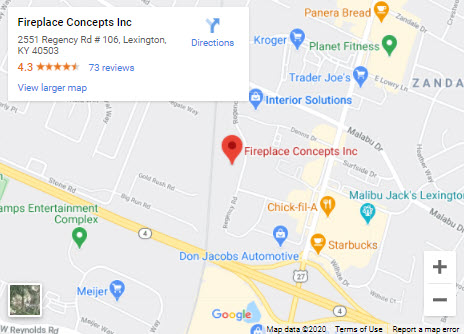
Gas Fireplace Venting Explained
Today’s gas fireplaces have become the most popular home hearth systems currently available on the market. Key reasons behind this include the fact that they offer tremendous convenience while also providing excellent safety. These fireplaces utilize a sealed combustion system that draws in the outside air for the fire while expelling all of the combustion exhaust and associated byproducts from the home. This helps to protect the indoor air quality of homes where gas fireplaces have been installed.
Gas fireplaces utilize a specialized type of venting to accomplish this job of protecting the air quality inside the homes where they are installed. This venting includes a two-chamber direct vent. The two chambers work in concert with one another. One of these chambers draws in oxygen from the outside. This is used for the fire. The other chamber expels the gases and byproducts of the fire back to the outside. These vents are usually horizontally terminated directly through the home’s wall. They can also be routed through a side or top vent.
What Kind of Venting Does a Gas Fireplace Need?
When it comes to the topic of gas fireplace venting explained, it is important to understand the type of venting that these fireplaces require. There are actually four varieties of gas fireplace vents that are commonly used. Each type of venting has its own benefits. It is important to consider each option and decide which one is best for your home if you are considering having a gas fireplace installed. The four primary types of gas fireplace vents are direct-vent, natural vent, power vent, and vent-free.
Direct-Vent – The direct-vent option is considered to be the safest when it comes to supplemental heating. These vents transfer pollutants and fumes from combustion to the home’s outside by way of the chimney or other exterior home openings. They also generally are used with fireplaces that include a sealed glass pane that is on the front of the unit. The peace of mind that all pollutants and odors will be removed is a key reason why this is such a popular option. It is estimated that 90 percent of gas fireplaces use a direct-vent system.
Natural Vent – Another type of venting that is used in gas fireplaces is a natural vent. This is also sometimes referred to within the industry as a B-vent. These vents take combustion air from the inside of the home and they vent the combustion products to the outside through a pipe venting system or a brick and mortar style chimney. These are the least popular types of vents due to their low efficiency. They can often be as little as twenty percent efficient which is enough to dissuade many homeowners from them. At the same time, they do produce a flame pattern that is the most attractive of all the vent varieties. Natural vents are the least expensive to install but they are more sensitive to in-home airflow than other varieties.
Power Vent – A third variety of gas fireplace venting is the power vent. They utilize an accessory that is powered by a fan. It is placed along the gas fireplace’s vent to give a boost to the air exchange. This is a popular venting option in cases where other types might not work well. An example of this would be where a fireplace is going to be installed in a freestanding wall.
Vent-Free – The fourth type of venting option to discuss regarding gas fireplaces is the vent-free one. The vent-free option does enjoy quite a bit of popularity. The benefit of vent-free systems is the fact that they are up to ninety-nine percent efficient. The warmth generated by these gas fireplaces will stay in the room where it has been installed. A downside is the fact that combustion pollutants remain in the room. Due to this, these types of fire
Should the Vent Be Open or Closed on Gas Fireplace?
Those considering the installation of a gas fireplace will commonly ask if the vent should be open or closed. What is important to remember is the fact that the fireplace needs to be able to vent to the outside. This is due to the production of products such as carbon monoxide. Because of this, it is important to keep the vents open on a gas fireplace until the fire has gone out completely.
How Can I Tell If My Gas Fireplace Is Venting Properly?
Another important question within the topic of gas fireplace venting explained is how you can know if your gas fireplace is venting properly. There are signs that you can look out for that indicate that there is an issue. One of the tell-tale signs that there is a venting issue is smoke that blows back into the room where the fireplace is installed.
Some of the key issues that can cause venting problems include chimney blockages, negative pressure that causes backdrafting, or a firebox that is not big enough. Whenever you notice the signs that your gas fireplace is not venting properly, it is time to contact trained fireplace experts such as our team here at Fireplace Concepts Inc.
Do You Need to Open a Window When Using a Gas Fireplace?
Homeowners also typically ask if it is necessary to open up a window when a gas fireplace is in use. It is the case that carbon monoxide can build up inside your home when a gas fireplace is in operation. Because of this, it is often recommended that a window is open while it is running so that the gas can be vented that way as well. Opening up a window will help to let in fresh oxygen which is a benefit.
You can find out more about the topic of gas fireplace venting explained or get answers to any other questions that you have about the gas fireplace topic by contacting our team at Fireplace Concepts Inc. We are the leading gas fireplace experts here in the Lexington, Kentucky region. Reach out to our team today to find out more about gas fireplace installation or any of the other fireplace services that we offer across the region.

